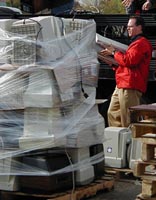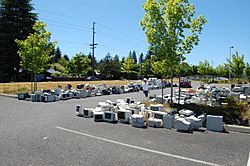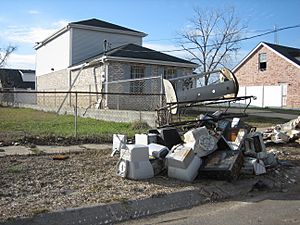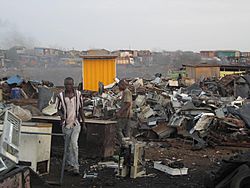Computer recycling facts for kids
Computer recycling, also called electronic recycling or e-waste recycling, is when we take apart old electronics to get valuable parts and materials back. While not strictly recycling, reusing, donating, or fixing old electronics are also great ways to help the planet.
In 2009, about 38% of computers and a quarter of all electronic waste in the United States were recycled. This number has grown since the early 1990s as more people learn about recycling. We recycle electronics mainly to get back valuable rare earth metals and precious metals, which are in short supply, along with plastics and other metals. These materials are then cleaned and used to make new devices. This helps create a "circular economy" where materials are used again and again.
Recycling is good for the environment because it stops dangerous chemicals and heavy metals from polluting our air, land, and water. Even though electronics are a small part of our trash, they can be much more harmful. There are laws, like the Waste Electrical and Electronic Equipment Directive in the European Union, to make sure electronics are recycled safely.
Some people think recycling is too expensive or doesn't protect your personal information. Also, sometimes old electronics are sent to other countries, where they are taken apart in ways that can be dangerous for people and the environment.
Contents
Why Recycle Old Electronics?

Old computers and electronics are full of valuable materials that can be used again. But if they're not recycled, these devices can release harmful chemicals. Because technology changes so fast and new devices are often cheap, many computers and electronics quickly become old.
The United States Environmental Protection Agency (EPA) estimated that 30 to 40 million personal computers would need to be recycled in just a few years. The U.S. National Safety Council believes that 75% of all personal computers ever sold are now old electronics.
In 2007, the EPA said that over 63 million computers in the U.S. were replaced or thrown away. Today, only about 15% of electronic devices in the United States are recycled. Most electronic waste ends up in landfills or is burned. This releases materials like lead, mercury, and cadmium into the soil, water, and air, which harms the environment.
Many materials in computer parts can be recovered through recycling. Reusing materials like tin, silicon, iron, aluminium, and different plastics from old electronics can lower the cost of making new systems. Parts often contain lead, copper, gold, and other valuable materials that can be reclaimed.
Computer parts also contain many toxic substances, like dioxins, polychlorinated biphenyls (PCBs), cadmium, chromium, radioactive isotopes, and mercury. For example, a typical computer monitor can have more than 6% lead by weight, mostly in its cathode ray tube (CRT). Some monitors can even have up to 8 pounds (3.6 kg) of lead. Circuit boards contain lead-tin solders that can leak into groundwater or cause air pollution if burned. The processes used to get back valuable metals can also release harmful byproducts.
Sending waste to countries with weaker environmental rules is a big worry. The Basel Convention is an agreement that says hazardous wastes, like old computer screens, should not be sent between continents without permission from both the sending and receiving countries. Some companies might find it cheaper to sell old computers to less developed countries with fewer rules. Many believe that most old laptops are sent to developing nations as "dumping grounds for e-waste." However, working laptops and parts like RAM can be valuable and help pay for shipping. Laws are in place to stop "recycling companies" from sending waste to other countries by pretending they are working devices. Often, workers in these countries take out valuable parts and throw the rest away, creating health risks.
Rules for Recycling Electronics

Europe's Rules
In Switzerland, the first electronic waste recycling system started in 1991. It began with old refrigerators and slowly added all other electronic devices. The European Union started a similar system in February 2003, called the Waste Electrical and Electronic Equipment Directive (WEEE Directive).
It took some time for all European countries to adopt this law. The success of the WEEE directive has been different in each country. In Europe, computers and electronics from homes are recycled under the WEEE directive. This is done through "Producer Compliance Schemes," where electronics makers pay into a system that helps collect their old products from recycling centers.
However, recycling old computer equipment from businesses is different. In the UK, old business computers are handled by special "Authorized Treatment Facilities" that usually charge a fee to collect and process them.
Asia's Rules
In Japan, companies that sell and make certain electronics, like televisions and air conditioners, must recycle them. But there are no laws for recycling computers or cell phones.
In South Korea and Taiwan, electronics sellers and makers must recycle 75% of their used products.
A report by the United Nations Environment Programme (UNEP) said that the amount of e-waste, including phones and computers, could increase by as much as 500% in some countries, like India, over the next ten years.
Some people think that strict rules about electronic waste in richer countries make it cheaper to send waste to developing countries instead of cleaning it first. Critics say it's too easy for companies that claim to be recyclers to send uncleaned electronic waste to countries like China, India, and parts of Africa. This helps them avoid the high cost of removing dangerous parts like old TV tubes. These developing countries are becoming big e-waste dumps. Others argue that fair trade programs, like those in other industries, can create good jobs and bring affordable technology to countries where more items are repaired and reused.
Organizations like A2Z Group in India are working to collect and recycle e-waste in different places.
South Africa's Rules
Thanks to laws like the National Environmental Management Act of 1998, anyone who harms the environment and doesn't follow waste rules in South Africa can face big fines or even jail time.
How We Recycle Electronics

Recycling for Individuals
If you have old electronics, you can sell them, donate them to organizations, send them back to the company that made them, or take them to a recycling center.
Taking Apart and Recycling
The rising price of valuable metals and high unemployment have led more people to recycle electronics for money. Parts from computers, for example, are taken apart for their most valuable pieces and sold as scrap. Metals like copper, aluminum, lead, gold, and palladium are recovered from computers, TVs, and more.
In the recycling process, TVs, monitors, phones, and computers are first checked to see if they can be reused or repaired. If they are broken, they might be taken apart for valuable pieces, especially if labor is cheap. Other e-waste is shredded into small pieces, about 4 inches (100 mm) long. Workers then manually remove toxic batteries and capacitors that contain poisonous metals. The remaining pieces are shredded even smaller, to about 0.4 inches (10 mm). A magnet removes iron and steel. Then, a special machine uses an eddy current to separate other metals, which are then sorted by weight. Valuable metals can be dissolved in acid, sorted, and melted into new blocks. The remaining glass and plastic are separated and sold to companies that can reuse them. TVs and monitors must be taken apart by hand to remove lead from old CRTs or mercury from flat screens.
Recycling for Businesses
Businesses that need to recycle many computers responsibly have a more complex process.
Companies can also sell their old equipment or contact the original manufacturers to arrange recycling.
Some companies pick up unwanted equipment from businesses, wipe all data from the systems, and estimate the product's remaining value. For items that still have value, these firms buy the old IT hardware and sell refurbished products to people looking for cheaper options than buying new.
Companies that specialize in data protection and green disposal make sure both data and used equipment are handled safely. They follow strict rules to protect the environment. Professional IT Asset Disposition (ITAD) firms specialize in corporate computer disposal and recycling. They follow local laws and regulations and offer secure data elimination services that meet high standards like those from the National Institute of Standards and Technology.
Businesses face risks if data is not completely erased or if computers are not disposed of properly. In the UK, some recycling companies use special contractors to dispose of IT equipment safely and legally. In America, companies are responsible for following regulations even if they hire another company to do the recycling. Businesses can reduce these risks by getting waivers, audit trails, certificates of data destruction, and checking their security processes.
Selling Old Electronics
Selling old electronics online can be an option for individuals. However, it can be complicated and competitive, and sometimes listings might not sell. Online classified ads can also be risky due to scams.
Trade-in Programs
When buying a new computer, you can ask if the company offers recycling services. Most major computer makers have some form of recycling. You might be able to mail in your old computers or arrange for the manufacturer to pick them up.
Hewlett-Packard offers free recycling for some products and will pick up any computer product of any brand for a fee. They might also offer a coupon for future purchases. Hewlett-Packard was a big computer recycler in America in 2003 and has recycled over 750 million pounds (340 million kg) of electronic waste worldwide since 1995.
Exchanging Old for New
Manufacturers often offer a free replacement service when you buy a new PC. Dell Computers and Apple Inc. take back old products when you buy a new one. Both companies fix up and resell their own computers with a one-year warranty.
Many companies buy and recycle all brands of working and broken laptops and notebook computers from individuals and businesses. It has been harder to create a market for recycling desktop computers compared to laptops, smartphones, and other smaller electronics. A common business model is to give a seller an instant online price based on the laptop's features, then send a shipping label and box. After receiving the laptop, they erase, reformat, and process it, then pay the seller quickly. Many of these companies also recycle other types of electronic waste. Some companies, like Cash For Laptops, focus only on buying laptops online.
Donating to Nonprofits
With rising costs, many families and schools don't have enough money for computers. Families affected by disasters also struggle. Many nonprofit organizations, like InterConnection.org, collect and give away computers. They can be found locally and online and explain how to donate. These efforts help thousands of people in need around the world. In Canada, groups like The Electronic Recycling Association and Computers for Schools Canada collect and fix computers and laptops to help charities and schools.
Junkyard Computing
"Junkyard computing" is a fun term for using old or less powerful computer parts to do computing tasks. The idea is that if one part breaks, software can handle it, making it easy to replace. This became more popular with tools like Kubernetes, which can manage many computers working together. This method is great for mid-sized projects that need a lot of computing power but also need to be cost-effective.
History of Electronic Recycling
Even though electronics like radios were popular in the 1920s, recycling them was rare until the early 1990s. By the late 1970s, new electronics like TVs and VCRs were being made so fast that their useful life became much shorter. New inventions came out quickly, making older equipment seem old-fashioned. It also became harder to fix things locally because they were more complex. People started replacing items quickly instead of repairing them. This was very clear with computers, as Moore's law meant new, faster models came out all the time.
In 1988, two serious events showed the growing e-waste problem. A ship called the Khian Sea dumped over 14,000 tons of toxic ash into the ocean after it was refused in many places. Also in 1988, a large illegal toxic waste dump was found in Italy. These events led to the creation of the Basel Convention in 1989, which aimed to stop poisonous waste from being sent from rich countries to poorer ones.
In 1991, Switzerland started the first electronic waste recycling system, beginning with old refrigerators and then expanding to all devices. An organization called SWICO, a partnership of IT retailers, manages this program.
The first news report about computer and electronic waste recycling appeared in The New York Times in 1993. It talked about a small recycling company trying to safely take apart computers, even though most waste still went to landfills. Other companies started in the early 1990s, especially in Europe, where new laws made retailers responsible for taking back old electronics.
After these systems were set up, many countries couldn't handle the huge amount of e-waste or its dangerous nature. They started sending the problem to developing countries that had fewer environmental laws. This was cheaper; for example, recycling computer monitors in the US cost ten times more than in China. Demand for electronic waste grew in Asia when scrap yards found they could get valuable materials like copper, iron, silicon, nickel, and gold from the recycling process.
The Waste Electrical and Electronic Equipment Directive (WEEE Directive) became a European law in February 2003. It covers all types of appliance recycling. This was followed by the Electronic Waste Recycling Act in California in January 2005.
The 2000s saw a big increase in both the sale of electronics and the amount of e-waste. In 2002, e-waste grew faster than any other type of waste in the EU. This led to investments in modern, automated facilities to handle the large amount of old appliances.
What is E-cycling?
"E-cycling" is a term used by the Environmental Protection Agency (EPA). It means donating, reusing, shredding, and collecting used electronics. Generally, it refers to the process of collecting, buying, taking apart, repairing, and recycling the parts or metals found in used or thrown-away electronic equipment, also known as electronic waste (e-waste). "E-cyclable" items include TVs, computers, microwaves, phones, stereos, and anything else with a cord, light, or battery.
More money is being invested in e-cycling facilities because technology becomes old very quickly. There are also concerns about wrong recycling methods and chances for manufacturers to be involved in the market for used products. Higher metal prices also encourage more recycling.
Good Things About E-cycling
When e-waste is sent overseas to developing countries for processing, it can sometimes be unethical or illegal. It's sent as if it will be repaired or recycled, but often the less valuable e-scrap becomes pollution there. However, getting new metals from mining can also harm the environment. Proper e-cycling, whether done locally or overseas, can help the environment by preventing pollution. E-cycling can be a good way to avoid putting e-waste in landfills. Also, e-cycling helps us get back valuable materials like gold, which means less need for new mining.
Some people who support "required e-cycling" laws say it saves taxpayers money because the cost shifts from taxpayers to manufacturers. Others argue that involving manufacturers doesn't lower costs for consumers, as the costs are passed on in new products. It's thought that manufacturers involved in e-cycling would be encouraged to use fewer materials, make products that last longer, and create safer recycling systems.
Problems with E-cycling
Critics of e-cycling say it raises the cost of products and waste management for consumers and can slow down new ideas from tech companies. They also believe that e-cycling facilities could accidentally harm the environment. Critics claim that e-waste doesn't make up a large part of all waste. One European study found that only 4% of waste is electronic.
Another problem with e-cycling is that taking things apart is costly and dangerous due to the heavy metals in electronics. Also, only a small percentage (1-5%) of the original material cost can be recovered. A final concern is that identity fraud is common when electronic products are disposed of.
Where Does E-waste Go?
A common criticism of recyclers who focus on reuse is that people think their electronic waste is being recycled, but it's actually sent to developing countries like China, India, and Nigeria. For example, at free recycling events, "recyclers" might not keep their promise and instead sell e-waste overseas or to parts dealers. Studies suggest that 50-80% of e-waste from the U.S. is sent overseas, and about 2 million tons (1.8 million tonnes) per year go to U.S. landfills.
The best way to e-cycle is often to "upcycle" e-waste, meaning to reuse it in a new way. However, the electronic products in question are often made and repaired in the same countries that some anti-reuse recyclers describe as "primitive." Reuse-based e-recyclers believe that fair trade for export markets will lead to better results than just shredding everything at home. There's an ongoing debate between allowing e-waste export and having more rules about it.
In the European Union, discussions about e-waste export led to a big change in the WEEE directive in January 2012. The goal was to greatly reduce the export of untreated e-waste. During a debate, lawmakers said that "53 million tonnes of WEEE were generated in 2009 but only 18% collected for recycling," with the rest being exported or sent to landfills. The new rules removed the focus on reuse (repair and refurbishment) and put more importance on recycling and recovering valuable metals. The changes also made it the responsibility of exporters to prove that used equipment leaving Europe was "fit for purpose."
Rules and Current Efforts
Currently, government laws and local efforts are helping e-cycling grow, focusing on less export and more reuse. California passed the California Electronic Waste Recycling Act in 2003. It requires consumers to pay an extra fee for certain electronics. This money then goes to recycling companies that are approved to properly recycle these products. California is the only state with this type of consumer fee. Other states focus on laws that make manufacturers responsible or ban e-waste from landfills.
As of September 2006, Dell started the first completely free recycling program in the U.S., showing how manufacturers are taking more responsibility for e-cycling. Companies like Best Buy, Sony, and Samsung have also set up recycling programs. However, this program doesn't accept TVs, which are expensive to recycle.
Another step is the recyclers' pledge of true stewardship, supported by the Computer TakeBack Campaign. Many recyclers have signed it, promising to recycle responsibly. Local efforts and community groups are also helping to recycle e-waste responsibly. Other groups include Basel, the Computer TakeBack Campaign, and the Silicon Valley Toxics Coalition.
Many people believe the U.S. should follow the European Union's model for e-waste. In Europe, a rule makes manufacturers responsible for e-cycling. It also requires manufacturers to take back products and bans sending e-waste to developing countries. Another long-term idea is to make computers with fewer dangerous materials.
Protecting Your Data When Recycling
E-waste can be a risk to your personal information and to countries that export it. If hard drives are not properly erased before a computer is thrown away, sensitive information can be found. Things like Credit card numbers, private financial data, and online transaction records can be accessed by people who know how. Organized criminals in Ghana have been known to search drives for information to use in local scams.
Government contracts have even been found on hard drives in Agbogbloshie, Ghana. Important agreements from U.S. security groups like the Defense Intelligence Agency (DIA) and Homeland Security have shown up there.
Why Securely Destroy and Recycle?
It's important to make sure that not only your old computer parts are destroyed, but also the private data on the hard drive. If customer data is stolen or lost, it can lead to identity theft, which can cost companies a lot of money and damage their reputation. Companies that handle sensitive data, like banks or law firms, are especially at risk. If their public image is hurt, customers might stop using their services, leading to big financial losses. The cost of data breaches can be very high, sometimes thousands of dollars per customer record.
Consumers can also react strongly if a company they trusted to protect their private information has a data breach. If an organization has any customer information, they must have written policies to prevent, reduce, and find weak spots that could lead to identity theft. The United States Department of Defense has a standard for recyclers to follow to meet privacy requirements.
Secure Recycling Methods
Countries have created standards to help businesses keep data secure on old computer media. For example, the NIST 800-88 is a U.S. standard for data wiping. The National Association for Information Destruction (NAID) is an international group for companies that destroy information. They promote good standards and ethics for their members. Some companies follow NAID guidelines and also meet environmental rules.
A typical process for secure computer recycling aims to destroy hard drives safely while still recycling the materials:
- Hardware for destruction is received in locked and securely transported vehicles.
- Hard drives are shredded.
- All aluminum is separated from other metals using a magnet.
- The shredded remains are collected and sent securely to an aluminum recycling plant.
- The remaining hard drive parts are melted into aluminum blocks.
The Asset Disposal and Information Security Alliance (ADISA) publishes a security standard for IT asset disposal. It covers all steps of the e-waste disposal process, from collection to storage and data cleaning at the recycling facility. They also check disposal companies regularly.
Images for kids
See also
 In Spanish: Reciclaje de computadoras para niños
In Spanish: Reciclaje de computadoras para niños







